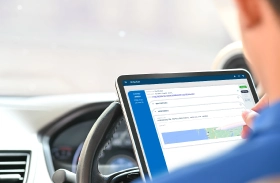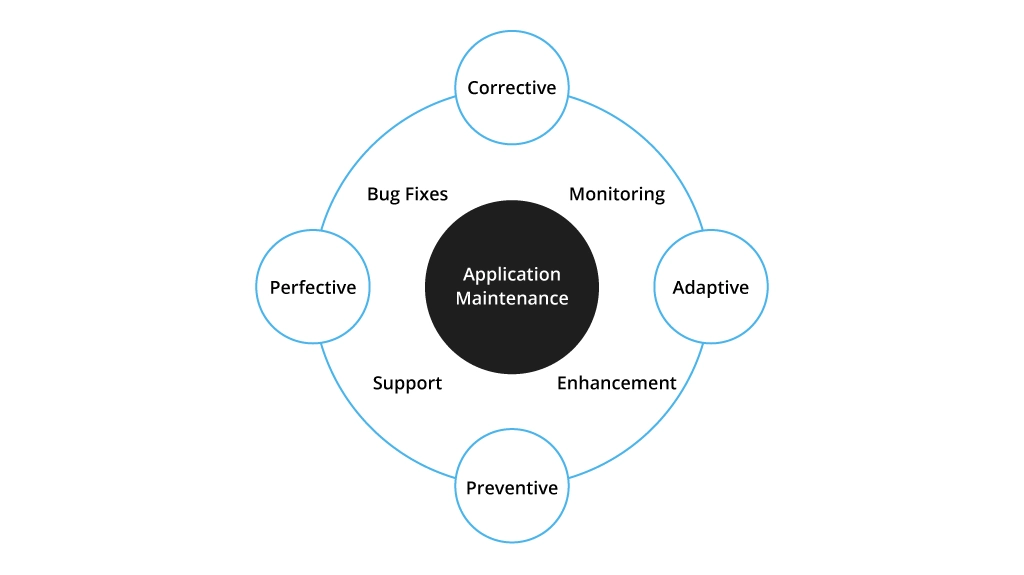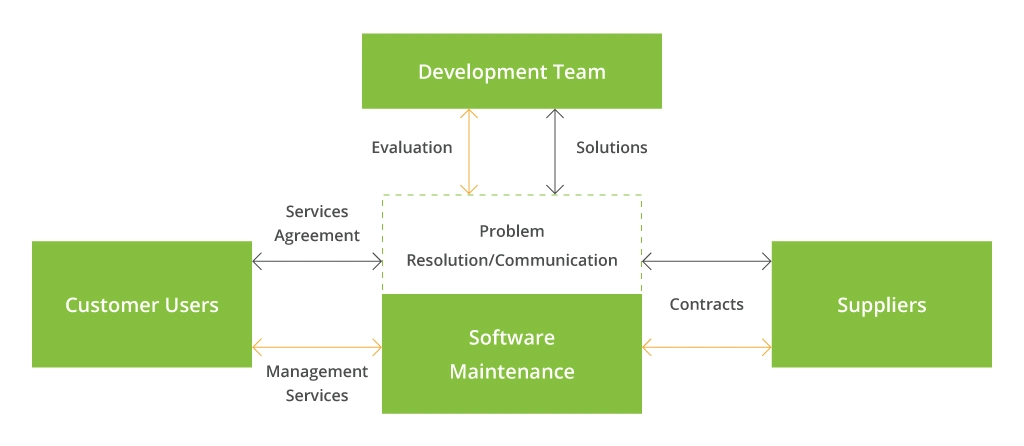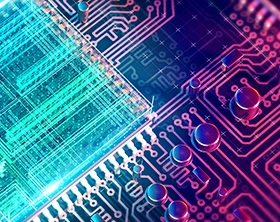The Importance and Best Practices of Software Maintenance
After the software is released to end users, specific issues inevitably appear. The speed and quality of addressing these issues often define whether customers will stay with your product or switch to another. For instance, 11% of mobile app uninstalls occur due to technical crashes and bugs. Moreover, the latter incur high expenses in the future. CISQ reports that poor software quality cost the USA about $2.41 trillion in 2022. So, how should you prevent software quality issues before they impact end-users and bring business losses?
In this article, we will uncover this and other tips to enable proactive software maintenance. You will learn to combine different types of software management into a balanced, cost-effective strategy.
What Is Software Maintenance?
Primarily, software maintenance is about updating and changing existing software to make sure it keeps working correctly and meets the evolving needs of users. The process involves
- Bug fixing: fixing software errors and issues found during its use.
- Performance optimization: enhancing the product's speed, efficiency, and reliability.
- Feature enhancements: adding new functionalities or perfecting existing ones to meet the evolving user needs.
- Migration: adapting the software to run on new hardware or virtual environments.
- Re-engineering: improving the architecture and design to make a solution more scalable and maintainable. Infopulse performed such an architecture redesign for a global personal coaching platform.
- Documentation: creating and maintaining the software documentation, including technical specifications, design documents, and user manuals.
Software maintenance is performed after it has been delivered to the customer and goes way beyond fixing the errors. It is critical for keeping the product competitive and relevant to its target audience.
Why Does Software Maintenance Matter?
Those companies that have a well-crafted strategy for software maintenance know that the process itself covers more than just bug-fixing or addressing customer support requests:
- Improving reliability and stability: Regular maintenance helps identify and fix bugs and errors to prevent downtime and severe impact on user experience.
- Optimizing performance: Addressing issues like inefficient code, hardware limitations, and memory leaks helps improve performance speed and efficiency. Within the growing data traffic loads, it is also essential to timely scale up the infrastructure to keep the software up and running.
- Improving security: software maintenance involves numerous activities to fix known vulnerabilities and prevent emerging threats. It ensures a more secure computing environment and efficient data protection. Read how Infopulse helped modernize a legacy External Independent Testing system and fix its critical security flaws within tight deadlines to save the nationwide admission campaign in Ukraine.
- Reducing downtime and disruption: keeping the product available for use without interruptions is critical for business. That is why the software maintenance plan includes regular activities to identify and address issues leading to downtime.
- Adapting to changing technology trends: maintenance helps keep the software compatible with the newly appearing hardware and software and optimize its performance on new devices and platforms.
- Adapting to market demands: user behavior and expectations dynamically change. The product team should timely address those changes by implementing new features and improving usability. It helps a product stay relevant and competitive in the long run. In such a way, Infopulse engineers helped EG A/S to keep the leadership in the Nordic market of transport management systems.
From the technical point of view, it ensures software compatibility with the updating technologies, stable performance, and scalability.
From the business point of view, software maintenance keeps your product viable. It helps maximize its profitability by keeping it running smoothly, minimizing downtime risks, and responding to market demands.
Types of Software Maintenance
There are four types of software maintenance that software engineers may commonly use concurrently depending on the specific product type and the project needs:
- Corrective maintenance: focuses on identifying errors and fixing them to make the software work more accurately. Mainly it helps correct the issues revealed after the software has been launched to production. Such corrections cover faulty logic flows, non-workable features in specific use scenarios, code bugs, and other issues.
- Adaptive maintenance: this type of software maintenance adapts the product to the changes in its environment, including new operating systems and hardware to support changing business needs and others.
- Perfective maintenance: enhancing the system operations, performance, and usability is also included in the software maintenance plan. Improvements also imply finetuning the existing functionality or adding new features.
- Preventive maintenance: in-depth analysis and monitoring of how the software works help define the potential risks of vulnerabilities and mitigate them respectively before they affect end-users. Preventive software maintenance also implies updating the software documentation and optimizing the code for better maintainability and scalability.
After analyzing the specifics of the project and prioritizing the improvement areas, a maintenance team can define the required proportion of all activity types to maximize maintenance effectiveness within the available resources.
Proactive Approach to Software Maintenance
The combination of perfective, adoptive, and preventive maintenance refers to a proactive maintenance approach. It aims at recognizing the fundamental cause of product failures and rectifying them before they cause major issues. Proactive maintenance can be contrasted with reactive maintenance. Proactive maintenance occurs before a breakdown affects the product and end-user experience, whereas reactive maintenance is to correct the cause of the occurred breakage.
The key components of proactive software maintenance include:
- Bug fixing: finding and fixing errors and problems in the software
- Enhancements: adding new features or improving existing ones to meet the evolving user needs
- Performance optimization: improving the software’s speed, efficiency, and reliability
- Porting and migration: adapting the software to run on new hardware or software platforms
- Re-engineering: improving the design and architecture of the software to make it more maintainable and scalable
- Documentation: creating, updating, and maintaining the documentation for the software, including user manuals, technical specifications, and design documents
Proactive software maintenance should be a continuous process that occurs throughout the entire software life cycle. It is essential to have a well-defined software maintenance plan in place that includes testing and validation, version control, and regular communication with the software stakeholders.
While a proactive approach is a key to ‘prevent’ instead of ‘rescue’, it is combined with the regular bug fixing and support to form an all-round product maintenance. Proactive software maintenance helps increase ROI and strengthen the connection between business and technical product development teams.
Key Challenges Affecting Software Maintenance
Often, software product owners do not consider software maintenance as an integral part of their software lifecycle, applying to such services occasionally as a temporary measure to address some existing issues. Certain challenges hinder continuous maintenance adoption. The most popular ones include:
- Limited resources: comprehensive software maintenance consumes significant resources, time, and money, while not bringing immediate returns. It makes stakeholders doubt the need for regular maintenance. In case of limited resources, the updates and fixes are implemented slower. Sometimes, it can result in higher security risks and reduced quality of the delivered fixes.
- Lack of communication between engineers and stakeholders: regarding the current product state, its advantages and weak points, potential improvements, and recommendations for critical enhancements. Such a proactive position brings a better connection between technical and business product development, ensuring that technological improvements are perfectly aligned with the business needs.
- Legacy code: when software relies on outdated programming languages and frameworks, it can be challenging to maintain the product and make it relevant within the latest software standards. To move the product further, it should be significantly reworked and transferred to up-to-date technologies. Otherwise, keeping the software functional and compatible with the new platforms and devices becomes impossible. Infopulse helped Delta Medical transform its digital infrastructure to meet the company’s business objectives, improve scalability, and significantly reduce the system maintenance cost and effort.
- Poorly documented code: Oftentimes, the product code that has been developed by different developers or even teams lacks clarity and proper documentation. It gets more challenging to maintain such projects and takes more time to investigate the code base and identify all the existing and potential issues.
- Scope creep: within every new feature added, it becomes more and more complicated to maintain the full product performance. Within complexity growth, maintenance costs and time grow respectively. Without expanding the resources for maintenance, it can result in increased risks of errors and performance issues.
- Lack of expertise: in many companies, the maintenance team is often a small team of specialists with up to three roles, which is never enough to a keep stable and efficient maintenance. People tend to take vacations and sick leaves while the maintenance process is continuous. As a result, the time for addressing support tickets or adopting changes expands and the team fails to release critical changes on time.
- Lack of understanding: for the clients, it’s often hard to explain what they expect from software maintenance per se. Hence, at Infopulse we often try to clarify what our specialists can do when proactive maintenance is on, specifically monitoring a software product, analyzing how the client’s infrastructure manages a growing number of users and amount of data, identifying errors in logs, defining the maintenance tasks, and delivering updates by the outlined plan. Regarding technical support, the specialists can only address incoming support requests. So, when we talk about the proactive software maintenance, the initiative in identifying issues before they may turn into requests should come from the specialists, while with the classic support, requests already imply some software issues and the needed changes detected by stakeholders, end users, and others.
Addressing these challenges is a matter of clearly understanding your goals, choosing the correct maintenance strategy, and involving suitable specialists to uptake the required work scope. The programming code support requires quality assurance specialists, while infrastructure maintenance needs DevOps engineers to be involved. The maintenance team has to be assembled with the talent relevant to your project needs.
Best Practices for Efficient Software Maintenance
The standard software maintenance process consists of seven phases:

This way, the maintenance team implements any system changes from the problem identification to the final delivery. The question is, what is software maintenance strategy from the business point of view? How to organize the ground base for cost-effective and beneficial software maintenance?
First and foremost, take software maintenance as a fundamental aspect of your business that would allow delivering a reliable, secure, and up-to-date product throughout its entire lifecycle. Here are the best practices to follow.
- Create a detailed Service Level Agreement (SLA). It involves defining the terms, expectations, and responsibilities between the software maintenance provider and the client. It defines the parties involved, scope and objectives, services to be provided under the maintenance agreement, service levels and metrics, maintenance schedule, and availability. This way, it becomes easier to find a suitable provider and align the future outcomes with the initial goals.
- Create or hire a maintenance team. Based on the scope defined in SLA, assemble a maintenance team with relevant technical expertise. If your team lacks the required specialists, opt for hiring a dedicated team from an external provider.
- Set up regular communication inside the product team (stakeholders, developers, maintenance engineers, BDM specialists). It is essential for effective process management and aligning the maintenance activities with the business product development vision.
- Design a practical maintenance framework. The framework defines the parties involved, tools, and processes for fulfilling maintenance activities. The hired maintenance team must be able to follow your requirements and meet the requirements of the defined toolset and processes.
- Undertake Root Cause Analysis (RCA), Failure Modes and Effects Analysis (FMEA). Root cause analysis considers everything that could go wrong with the software, the impact of these failures on customers (end users), and what steps to take to prevent this negative impact. Failure Modes and Effects Analysis is an approach to RCA that helps understand the impact of potential failures, detail each failure mode, and assess it by severity, occurrence, and detection. As a result, each failure mode gets its score (risk priority number), and the maintenance team can plan their preventive activities according to the prioritized scope.
- Automate routine and repetitive maintenance activities. Automated software testing, performance monitoring, code reviews, production monitoring, and security audits save time and maintenance costs.
- Collect valuable data to analyze. Track records for maintenance activities, the implemented changes, and the outcomes they bring. Collect and analyze customer feedback, investigate market demands and trends to understand actual and potential opportunities for improvements. It all helps create balanced and relevant software maintenance scope.
- Ensure proper changes documenting. Without appropriate documentation, it gets more and more challenging to maintain software with time. Ensure all the code and software infrastructure modifications are properly documented and adopt appropriate practices to maintain them.
From the client side, building a balanced software maintenance strategy requires clarifying goals and requirements (SLA), investing enough time to communicate processes and progress, and contributing to maintenance team creation. An experienced software maintenance provider can undertake the rest. If you have already delegated custom software development to an external provider, it makes sense to opt for software maintenance service from the same team, as they know all the ins and outs and have the required skill set. This way, Infopulse provided a multi-level software maintenance and support for a qualification system it developed for an EU-wide oil and gas non-profit association. Such a decision brought the client accurate and timely system updates with no need to onboard new specialists.
Alternatively, opt for the maintenance team with experience in developing and maintaining your software type. In one of the projects, Infopulse successfully complemented an in-house maintenance team of a Telecom Giant to fulfill its growing needs for timely technical assistance.
Conclusion
To succeed in the long run, software maintenance must become a part of the product development strategy. It should be a continuous, well-thought process focused more on proactive maintenance that helps prevent failures before they cause losses and stay continually competitive in the market.
While software maintenance is often costly and resource-consuming, you can significantly optimize it by:
- Clarifying your goals
- Planning the maintenance scope and processes
- Hiring a qualified, experienced team
- Automating routine maintenance activities as much as possible
- Conducting continuous analytics to get meaningful insights for improvements
Infopulse provides software maintenance under its managed application services. Our specialists provide flexible L1/L2/L3 support and maintenance with the right set of expertise, including software development, UI/UX development, DevOps, quality assurance, marketing, and business analytics. Ensure your software stays up-to-date and bug-free with our dedicated maintenance assistance.
![SW Maintenance [main banner]](https://www.infopulse.com/uploads/media/banner-1920x528-the-importance-of-software-maintenance.webp)







![How to Build Enterprise Software Systems [thumbnail]](/uploads/media/thumbnail-280x222-how-to-build-enterprise-software-systems.webp)
![Software Development Models [thumbnail]](/uploads/media/thumbnail-280x222-software-development-models.webp)
![Hidden costs [thumbnail wide]](/uploads/media/thumbnail wide-454x222-how-to-account-for-hidden-costs-in-software-development-plans.webp)








